How did Logical Emotion: Contemporary Art from Japan Come About?
Kenjiro Hosaka (Curator, The National Museum of Modern Art, Tokyo)
The Japan Foundation presented Logical Emotion: Contemporary Art from Japan, an exhibition jointly organized by curators from Japan and Switzerland, to commemorate the 150th anniversary of diplomatic relations between these two countries. After opening at Museum Haus Konstruktiv (Zurich, Switzerland) in October 2014, the exhibition went on tour in Poland and Germany. One of its co-curators, Kenjiro Hosaka, has reflected on the exhibition and written about its concept, the challenges specific to a traveling exhibition, and the reactions of the media in each country.
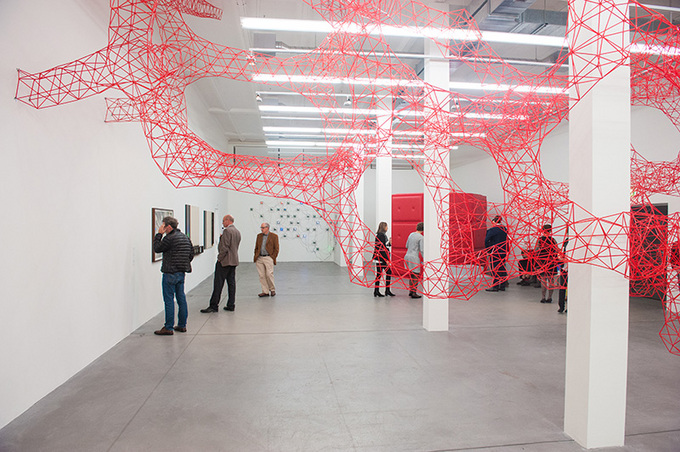
The exhibition at Museum Haus Konstruktiv (Zurich)
Courtesy of Museum Haus Konstruktiv
Photo © Ilja Tschanen
How was the concept created?
This exhibition sprang from the idea to organize an exhibition on Japanese contemporary art in Switzerland in 2014, which marked the 150th anniversary of diplomatic relations between Japan and Switzerland. After reviewing a number of art museums, Museum Haus Konstruktiv in Zurich was ultimately chosen. While there were several reasons for selecting this museum, it was important that the museum be interested in co-curating the exhibition with Japan, have an adequate system to provide security for the exhibited works, and offer extensive educational programs.
Run by the Foundation for Constructivist, Concrete and Conceptual Art, Haus Konstruktiv is a slightly unique museum. It is essentially a foundation for promoting constructivist art, "concrete art," and conceptual art. Haus Konstruktiv is an art museum that was established with a mission to carry out this promotion.
The word "concrete" in "concrete art" does not refer to the material, and neither does it refer to the opposite term for "abstract." Its meaning is more like "embodiment" or "given shape." The term traces its origins to Manifesto of Concrete Art released by Dutch artist Theo van Doesburg in 1930. Van Doesburg wrote that nothing is more concrete and real than a line, a color, and a surface. Concrete art aimed to achieve perfect abstraction that had absolutely no basis in the observable real world and was entirely devoid of symbolic meanings.
This spirit was upheld by Swiss artists led by Max Bill, and including the likes of Richard Paul Lohse and Camille Graeser. Just as postwar Japanese art cannot be explained without mentioning "Gutai" and "Mono-ha," "concrete art" is the first concept and movement that is noted when discussing Swiss art from the 20th century and beyond.
I have explained the uniqueness of Haus Konstruktiv at length because the above definitions were given as the terms for creating the exhibition's concept. In other words, Haus Konstruktiv requested that the works displayed in the exhibition be based on its mission, and be thoroughly abstract, constructivist, and conceptual.
When I heard these terms, I was at a loss. It was possible to organize an exhibition of contemporary Japanese art comprised only of works that can be called "concrete art," and I imagine it would have some significance. However, such an exhibition would by its very nature fail to convey the present-day Japanese art scene.
At the same time, however, I thought the terms were intriguing. Organizing an exhibition on Japanese contemporary art is first and foremost an ambiguous process and the possibilities are endless. In considering which works to select from the myriad of choices, the mission of Haus Konstruktiv can provide sufficient clues. Furthermore, pop expressions that many people likely expect when they hear "Japan" can be excluded from the very beginning. The terms of the museum enabled an exhibition that emphasizes universality more than particularities.
Museum Haus Konstruktiv Director Sabine Schaschl and I came up with the concept of "logical emotion." In broad terms, "logical emotion" can be explained in the following way. Nonverbal emotions are at the root of not only art, but also human acts of expression in general. Humans are creatures that attempt to create something by abstracting emotions into single or multiple aspects and by giving these emotions a concept. The process of studying this concept and approach is profoundly reflective. When this study is done by carefully envisaging the viewpoints of others, it can then be called art. In view of its actual situation, this process is called "logical emotion." While it may be strange for emotions to be logical, this is nothing more than a manifestation of the self-realization that the act of "abstracting emotions" at the beginning of the artistic creation process is full of contradictions.
Logical emotions are not a characteristic that is only observed in Japanese contemporary art. In my personal opinion at least, many works in the Western art scene (especially for a period of time after World War II) focused on either being logical (conceptual art) or emotional (neo-expressionism). It seems these works garnered high praise. In contrast, Japan had many works that were not fully conceptual, the representative example being the works of Koji Enokura. Or, as is represented by the works of Tadanori Yokoo (which were not included in the exhibition), there were many works that showed qualities of being made in the same era as neo-expressionism, but that were not focused on the emotional. That is to say, I perceived that in Japan, many works recognize the cycle in which the logical emerges from an emotional state, and what is left out of this process manifests again as the emotional, and the works attempt to drift about in this state. It occurred to me that this might be difficult to understand in cultures that emphasize clarity, and if so, why not take this opportunity to give a name to this approach?
It goes without saying that today, the "logical emotion" approach can be found in the artworks of cultures other than Japan - for example, in the works of Fischli/Weiss and Olafur Eliasson. In this sense, "logical emotion" may be too large of a framework for introducing Japanese contemporary art, and for this reason, it could lessen the impact. At the same time, however, I wanted to avoid descending into exoticism for the sake of impact. I wanted to create an exhibition that appeared to present Japanese characteristics, but in reality, presented the fundamental approaches of art (as envisioned by the artists of "concrete art"). This was the process from which the exhibition Logical Emotion: Contemporary Art from Japan emerged.
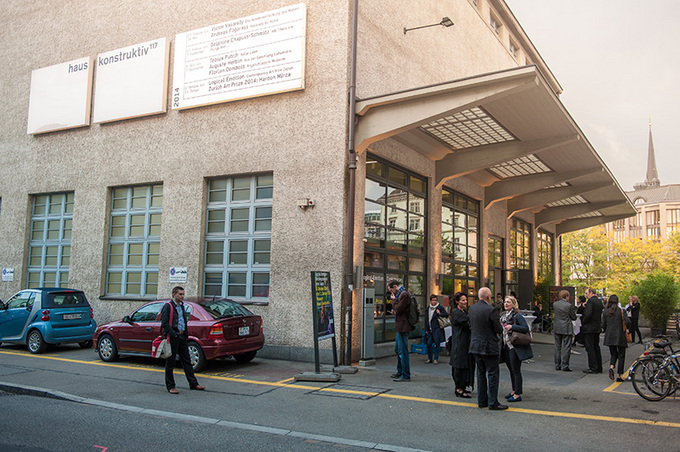
Exterior of Museum Haus Konstruktiv (Zurich)
Courtesy of Museum Haus Konstruktiv
Photo © Ilja Tschanen
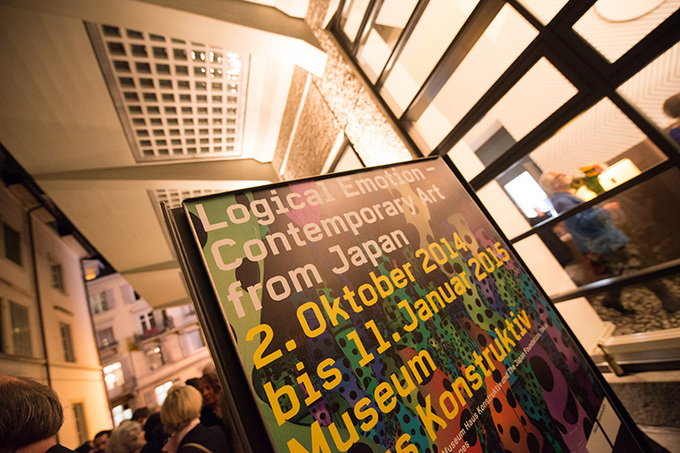
Poster of Museum Haus Konstruktiv (Zurich) for Logical Emotion: Contemporary Art from Japan
Courtesy of Museum Haus Konstruktiv
Photo © Ilja Tschanen
Challenges specific to a traveling exhibition
Conceptualized in Zurich, the exhibition Logical Emotion: Contemporary Art from Japan then traveled to Krakow and then to Halle (Saale). This was, in fact, easier said than done. Finding venues for a traveling exhibition that already has an established concept and for the right time period sought by the organizing side is an extremely challenging task. It is nothing short of a miracle that an efficient schedule was arranged for this traveling exhibition. I would like to take this opportunity to express my sincere appreciation to the people at the Japan Foundation who made this miracle possible thanks to their coordination capabilities.
The three cities chosen for the traveling exhibition were truly very different. Zurich is an international financial city as everyone is aware. Krakow is an ancient capital and one of the leading cities of Poland. It is also known for its proximity to Auschwitz (Oświęcim). In addition, the city has deep ties to Japanese culture. Lastly, Halle, a city in former East Germany, has a population of nearly 230,000 people, the largest population in the state of Saxony-Anhalt. Among music fans, the city is known as the hometown of Händel. Despite its location - about one hour from Berlin by ICE and about 30 minutes from Leipzig by local train, the city is hardly known among the general public. Incidentally, Halle is also the name of a city in the state of North Rhine-Westphalia where the Gerry Weber Open tennis tournament is held. To avoid confusion, the city in the state of Saxony-Anhalt sometimes is written as "Halle (Saale)," taking the name of the Saale River that flows nearby.
The difficulties of a travelling exhibition arise with the installation of the works. In the Logical Emotion exhibition, the selected artists, and the contents and number of works were decided based on the space in the museum in Zurich. Because the proportions of artist Hiroshi Sugito's atelier were nearly the same as those of the room where his works would be exhibited, we went to his atelier to do a study of the exhibition and decide on the works to be displayed as well as their installation. However, everything was of course different at the exhibition spaces of the other venues, including the floor area, ceiling height, and design taste of the rooms. This made it extremely challenging to consider the installation of the works.
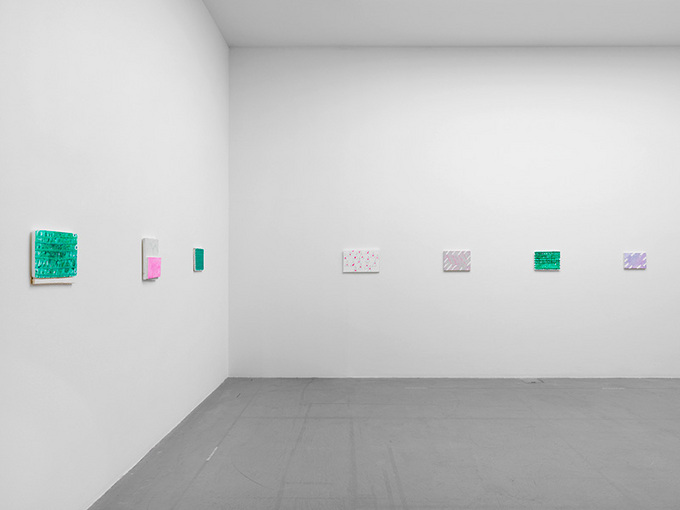
Works of Hiroshi Sugito on display at Museum Haus Konstruktiv (Zurich). Sugito's atelier was used for a study of the exhibition.
Courtesy of Museum Haus Konstruktiv
Photo © Stefan Altenburger
For example, our idea was to display the works of Koji Enokura in the introductory part of the exhibition both to symbolize its concept, and due to the fact that he was the only deceased artist in the exhibition. This is how we actually did it in Zurich. In Krakow, however, due to the particularities of the museum space and the strong wish of the local curator, Enokura's works were displayed in the mid-section (in a sense, at the central part) of the exhibition. Furthermore, the works of Teppei Kaneuji, which were exhibited in the last room in Zurich (which was also the room that became the turnaround point for traffic), were displayed in the first room in Krakow.

Left: Koji Enokura's works displayed in the introductory part of the exhibition (Museum Haus Konstruktiv, Zurich)
Courtesy of Museum Haus Konstruktiv
Photo © Ilja Tschanen
Right: Works displayed in the mid-section of the exhibition at Museum of Contemporary Art in Krakow (left: work of Kazunari Hattori, right: Works of Koji Enokura)
Courtesy of Museum of Contemporary Art in Krakow MOCAK
Photo © R. Sosin

Left: Display of Teppei Kaneuji's works (Museum Haus Konstruktiv, Zurich)
Courtesy of Museum Haus Konstruktiv
Courtesy of Museum Haus Konstruktiv
Photo © Stefan Altenburger
Right: Display of Teppei Kaneuji's works (Museum of Contemporary Art in Krakow)
Courtesy of Museum of Contemporary Art in Krakow MOCAK
Courtesy of Museum of Contemporary Art in Krakow MOCAK
Photo © R. Sosin
At an exhibition, a single story is formed based on the flow of the space, albeit it may not have been intended as such. In traveling exhibitions like this one, works of which are shown without being divided in chapters or with no specific exhibiting order, an entirely different story may be formed at each venue. Be that as it may, I am confident that, in the end, we were able to create a very effective "story" at each venue as a result of the discussions held with the local curators (and of course because the individual works are outstanding).
Local Media Reactions
Finally, I would like to present the reactions of the local media to this exhibition with some examples.
I will start with Zurich. In an article dated October 8, 2014 in the online newspaper, Neue Zürcher Zeitung, entitled "Head and Gut: Japanese Contemporary Art between Logic and Emotion," Philipp Meier noted the following:
What is noteworthy are Japan's manifold abilities to understand contemporary art. The exhibition features the works of not only so-called artists, but also of architects, graphic designers, manga artists, and even potters. Traditionally, art in the Land of the Rising Sun, unlike that in the West, did not meticulously distinguish the genres.
We, the exhibition organizers, decided to include works from architecture, graphic design, manga, and other genres to show that, at least in Japan, the "logical emotion" stance is found across the different genres. However, the reviewer construed this diversity not as evidence of the permeability of "logical emotion," but as an issue of the way that the concept of "art" is framed in Japan. This seems trivial, but it is in fact a fundamental "misreading" of the exhibition, and I believe it may serve as a reference for organizing similar exhibitions in the future. (Obviously I am not criticizing this "misreading"; rather, I am pleased by it.)
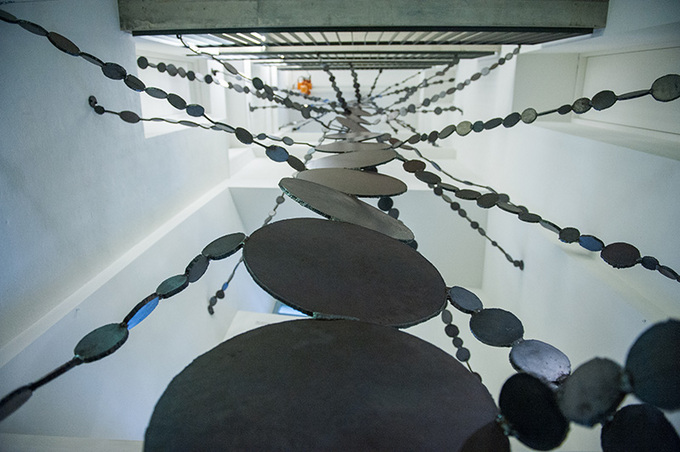
Display of Noe Aoki's work (Museum Haus Konstruktiv, Zurich)
Courtesy of Museum Haus Konstruktiv
Photo © Ilja Tschanen
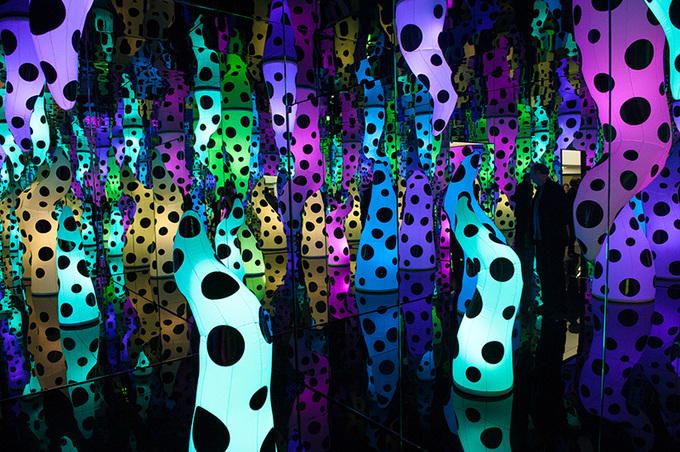
Display of Yayoi Kusama's work (Museum Haus Konstruktiv, Zurich)
Courtesy of Museum Haus Konstruktiv
Photo © Ilja Tschanen
Of course, there were also reactions that demonstrated our intentions had been understood. For example, with regard to the exhibition in Krakow, an article written by Karolina Przybylińska for an online magazine called rynek i sztuka [Art and Market] dated February 16, 2015 entitled "Can Emotions Be Logical?" stated the following:
[This exhibition] is an important contribution to deepening understanding of Japanese contemporary art that was deprived of its leading status by traditional art and pop art rooted in the stereotypical mindsets of Western viewers and others. Thanks to this exhibition, Polish viewers may have been given an opportunity to close its distance with the culturally different Japan, learn about Japan from an alternative angle, and find similarities.
I have to say, it does make me happy to know the organizer's intention, to provide opportunities to find similarities rather than differences, was understood.
In Halle, a June 13, 2015 article by Kai Agthe in Mitteldeutsche Zeitung entitled "Multimedia Wonderland" contained the following interesting comment:
However, the one thing missing was a political perspective. (Abridged) Therefore, there was neither a statement on Fukushima nor a statement on other global themes. In comparison, Chinese artist Ai Weiwei makes a very political assertion in his installation of several hundred old chairs stacked together.
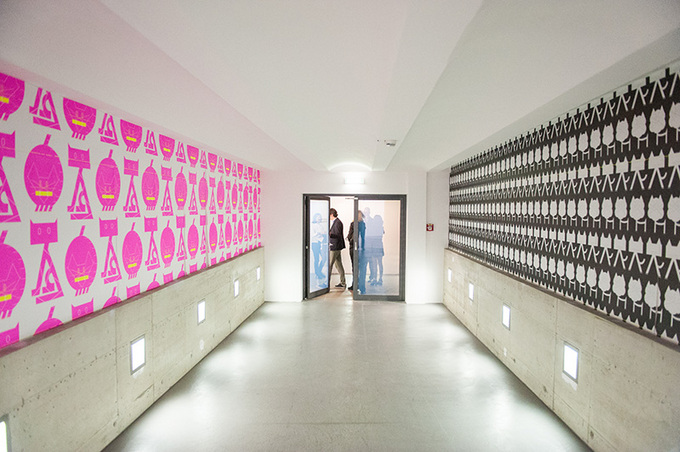
Display of Kazunari Hattori's works (Museum Haus Konstruktiv, Zurich)
Courtesy of Museum Haus Konstruktiv
Photo © Ilja Tschanen
This is a good example showing how even now, organizing an overseas exhibition of Japanese contemporary art will likely be subject to reviews of this nature. The primary reason was that the exhibition's first venue, Museum Haus Konstruktiv, did not in principle display works on themes related to current issues, and thus, they were not included in this exhibition. Such background, however, hardly matters to the reviewer. This is all the more evident in travelling exhibition destinations where these terms are hardly obvious. Although the exhibition was compared to Ai Weiwei's work, certainly not all Chinese artists (or all Asian artists) create works from a clear political standpoint like Ai Weiwei. If it is perceived as such, then it most likely suggests that people who hold this perception expect this stance from Chinese (or Asian) artists and this underlies their view of the exhibition.
I personally consider that continuing to leave open the possibility of going back and forth between being logical and emotional is a sufficiently "global" theme - just as Milan Kundera made this a theme of his novels, notably in The Unbearable Lightness of Being (I intentionally gave an example that will be clear to "Europeans").
What tends to get forgotten is that this exhibition was held at public museums. If it had been biennales or triennales, i.e., exhibitions held in the form of temporary festivals, then it would probably have been important to underscore political perspectives and highlight the current key "global" issues, and I am sure this would have been very effective. However, these festivals differ from exhibitions held at museums. While Museum Haus Konstruktiv is a slightly extreme example, public museums have their own respective missions. These missions were prepared not with a short time span in mind, but to last over many years in principle. One can even say they have redundancy. This means literary themes, so to speak, are more suitable for exhibitions organized and held at museums.
If the response to this is, "That is no good, exhibitions held at museums should be like biennales," then it means the necessity of (exhibitions held at) museums is not being understood (exhibitions held at museums have slipped into the shadows of the momentum of international exhibitions like biennales). If this is so, then this exhibition has served as a reminder for me that these exhibitions are all the more needed.
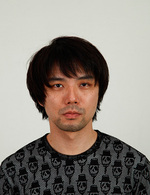 Kenjiro Hosaka
Kenjiro Hosaka
Kenjiro Hosaka was born in 1976 in Ibaraki Prefecture. He received MA in Aesthetics and Science of Arts from Keio University in 2000 and joined The National Museum of Modern Art, Tokyo (MOMAT) in the same year. He is currently a curator at MOMAT. Major exhibitions Hosaka organized at MOMAT in recent years include Francis Bacon (2013), Guess What? Hardcore Contemporary Art's Truly a World Treasure: Selected Works from the YAGEO Foundation Collection (2014), and Takamatsu Jiro: Mysteries (2014). He has organized exhibitions overseas including Double Vision: Contemporary Art from Japan (2012, Moscow Museum of Modern Art and elsewhere) and Logical Emotion: Contemporary Art from Japan (2014, Museum Haus Konstruktiv and elsewhere). He regularly writes for Subaru (Shueisha), The Asahi Shimbun, and Chic. In 2013, he served as monthly reviewer for Shinkenchiku (every other month). His major books include JUN AOKI COMPLETE WORKS 1 1991-2006 (co-authored, INAX Publishing, 2006), Kyurētā ni Naritai! Āto wo Yo ni Dasu Hyogensha [I Want to be a Curator! A Creator who Releases Art into the World] (edited, Film Art, 2009), Fukushi×Bijyutsu×Hyogen×Tamashii [Welfare×Art×Expression×Soul] (Supervised, 3331 Arts Chiyoda, 2013), and Āru Buryutto Āto Nihon [Art Brut Art Japan] (Supervised, Heibonsha, 2013). He is a part-time lecturer at Hirosaki University, Tokyo University of the Arts, Kanazawa College of Art, and Kyushu University.Art, and Kyushu University.
Profile photo: Keizo Kioku
Keywords
- Anime/Manga
- Design
- Architecture
- Arts/Contemporary Arts
- Japan
- Netherlands
- Switzerland
- Germany
- Poland
- Logical Emotion
- Museum Haus Konstruktiv
- Zurich
- Theo van Doesburg
- Max Bill
- Richard Paul Lohse
- Camille Graeser
- Gutai
- Mono-ha
- concrete art
- neo-expressionism
- Koji Enokura
- Tadanori Yokoo
- Fischli/Weiss
- Olafur Eliasson
- Krakow
- Halle (Saale)
- Auschwitz
- Oświęcim
- Händel
- Teppei Kaneuji
- Neue Zürcher Zeitung
- graphic design
- rynek i sztuka
- Mitteldeutsche Zeitung
- Ai Weiwei
- Milan Kundera
Back Issues
- 2022.11. 1 Inner Diversity<3> <…
- 2022.9. 5 Report on the India-…
- 2022.6.24 The 48th Japan Found…
- 2022.6. 7 Beyond Disasters - …
- 2021.3.10 Crossing Borders, En…
- 2020.7.17 A Millennium of Japa…
- 2020.3.23 A Historian Interpre…
- 2019.11.19 Dialogue Driven by S…
- 2019.10. 2 The mediators who bu…
- 2019.6.28 A Look Back at J…

